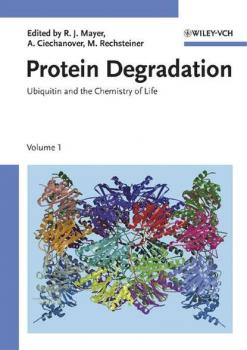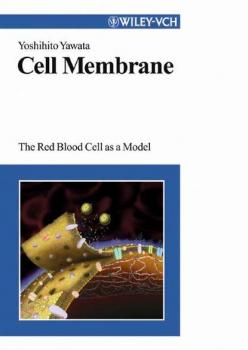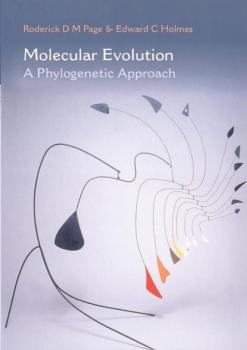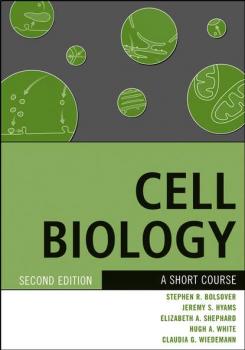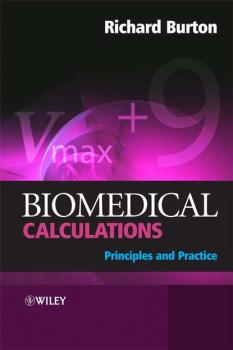ТОП просматриваемых книг сайта:
Прочая образовательная литература
Различные книги в жанре Прочая образовательная литература, доступные для чтения и скачиванияАннотация
The first volume in a new series dedicated to protein degradation, this book lays the foundations of targeted protein breakdown via the ubiquitin pathway. The outstanding importance of the ubiquitin pathway has been recognized with the 2004 Nobel Prize in Chemistry for Aaaron Chiechanover, Avram Hershko, and Irwin Rose. Aaron Ciechanover is one of the editors of this series, and Avram Hershko has contributed to the opening chapter of the present volume. Drawing on the the expertise of two Nobel prize winners, this handy reference compiles information on the initial steps of the ubiquitin pathway. Starting out with a broad view of protein degradation and its functions in cellular regulation, it then goes on to examine the molecular mechanisms of ubiquitin conjugation and recycling in detail. All currently known classes of ubiquitin protein ligases are treated here, including latest structural data on these enzymes. Further volumes in the series cover the function of the proteasome, and the roles of the ubiquitin pathway in regulating key cellular processes, as well as its pathophysiological disease states. Required reading for molecular biologists, cell biologists and physiologists with an interest in protein degradation.
Аннотация
This publication presents the structure and function of biological membranes to improve the understanding of cells in both normal and pathogenic states. Recently, vast amounts of new information have been accumulated, especially about pathological conditions, and there is now much evidence correlating genotypes and phenotypes in normal and disease states. This book surveys the most recent findings in research on the molecular biology, biochemistry, and genetics of the membranes of human red blood cells.
Аннотация
The study of evolution at the molecular level has given the subject of evolutionary biology a new significance. Phylogenetic 'trees' of gene sequences are a powerful tool for recovering evolutionary relationships among species, and can be used to answer a broad range of evolutionary and ecological questions. They are also beginning to permeate the medical sciences. In this book, the authors approach the study of molecular evolution with the phylogenetic tree as a central metaphor. This will equip students and professionals with the ability to see both the evolutionary relevance of molecular data, and the significance evolutionary theory has for molecular studies. The book is accessible yet sufficiently detailed and explicit so that the student can learn the mechanics of the procedures discussed. The book is intended for senior undergraduate and graduate students taking courses in molecular evolution/phylogenetic reconstruction. It will also be a useful supplement for students taking wider courses in evolution, as well as a valuable resource for professionals. First student textbook of phylogenetic reconstruction which uses the tree as a central metaphor of evolution. Chapter summaries and annotated suggestions for further reading. Worked examples facilitate understanding of some of the more complex issues. Emphasis on clarity and accessibility.
Аннотация
Transcription is the focus of much cutting-edge research, as befits its essential place in biology. The established link between defects in gene transcription and many human disorders has fuelled considerable activity in the biomedical arena, particularly cancer research. This concentration of attention has uncovered a myriad of factors involved in transcription and the literature is now rife with jargon and complexity. Gene Transcription: Mechanisms and Control aims to demystify the subject for a non-expert audience, providing a guided tour around the complex machinery of the transcriptional apparatus and discussing how the various factors achieve their functions. By focusing on general principles and illustrating these with a select group of examples, many of which are linked to human diseases, the author conveys the intricacies of transcriptional control in an accessible manner. With the first chapter presenting an overview of gene expression, this is a 'stand-alone' text, ideal for advanced level undergraduates and postgraduates in biology, biochemistry and medical sciences. It will also appeal to research scientists who require a broad current perspective on this rapidly moving and complex field. Provides a broad and accessible introduction to gene transcription. Up-to-date coverage of the major topics in a rapidly evolving field. Illustrates the links between aberrant transcription and human disease. Explains the jargon associated with transcription factors.
Аннотация
This text tells the story of cells as the unit of life in a colorful and student-friendly manner, taking an «essentials only» approach. By using the successful model of previously published Short Courses, this text succeeds in conveying the key points without overburdening readers with secondary information. The authors (all active researchers and educators) skillfully present concepts by illustrating them with clear diagrams and examples from current research. Special boxed sections focus on the importance of cell biology in medicine and industry today. This text is a completely revised, reorganized, and enhanced revision of From Genes to Cells.
Аннотация
Flow cytometry continually amazes scientists with its ever-expanding utility. Advances in flow cytometry have opened new directions in theoretical science, clinical diagnosis, and medical practice. The new edition of Flow Cytometry: First Principles provides a thorough update of this now classic text, reflecting innovations in the field while outlining the fundamental elements of instrumentation, sample preparation, and data analysis. Flow Cytometry: First Principles, Second Edition explains the basic principles of flow cytometry, surveying its primary scientific and clinical applications and highlighting state-of-the-art techniques at the frontiers of research. This edition contains extensive revisions of all chapters, including new discussions on fluorochrome and laser options for multicolor analysis, an additionalsection on apoptosis in the chapter on DNA, and new chapters onintracellular protein staining and cell sorting, including high-speed sorting and alternative sorting methods, as well as traditional technology. This essential resource: Assumes no prior knowledge of flow cytometry Progresses with an informal, engaging lecture style from simpleto more complex concepts Offers a clear introduction to new vocabulary, principles of instrumentation, and strategies for data analysis Emphasizes the theory relevant to all flow cytometry, with examples from a variety of clinical and scientific fields Flow Cytometry: First Principles, Second Edition provides scientists, clinicians, technologists, and students with the knowledge necessary for beginning the practice of flow cytometry and for understanding related literature.
Аннотация
It is said if you take care of the pennies, the pounds will take care of themselves. Richard Burton's excellent book takes this approach to calculations applied to the biomedical sciences…This is certainly interesting and engaging but it avoids being complicated. –Journal of Biological Education, April 2009 Biomedical Calculations: Principles and Practice is an accessible, student-friendly introduction to calculating, applying formulae and solving quantitative problems within these subjects. This book targets a problem area for many students and aims to give them the confidence which they are so often lacking when undertaking scientific calculations. It takes a unique approach to the subject and uses unit analysis as a central theme throughout the book to enhance student understanding. Clearly structured throughout, little basic knowledge of mathematics is assumed, but even the most numerate readers will be interested in the sometimes-novel biological detail. Numerous worked examples, supplementary questions and practice problems are provided and although the book is written to be read in sequence, it will also be a useful reference. The central theme of the book focuses on the value of unit analysis in solving quantitative problems, with explanations on how to avoid errors in calculations and in checking, understanding and deriving formulae and equations. As a background to this, there is extensive treatment of physical units, both individually (e.g. kg, m, mmol) and in combination (e.g. m s¯², mmol L¯¹), and also of other aspects of quantitative thinking. A variety of topics (mostly from physiology, pharmacology and biochemistry) are used to demonstrate these calculations in practice. Key features: An accessible, student-friendly introduction for all those hesitant in calculating, applying formulae and solving quantitative problems An innovative approach to scientific calculations and how to work with unfamiliar formulae for the biomedical and life sciences Includes modern, up to date definition of pH eliminating the need for logarithms and a discussion of the importance of pH Clear introduction on how to use the book, guidance on units and unit conversion, and an appendix on basic mathematics and notation Use of unit analysis as a central theme Includes numerous worked examples and supplementary questions throughout the text to enhance student understanding
Аннотация
With the recent renaissance in mitochondrial biology and increasing recognition of their role in many diseases, this book provides a timely summary of the current state-of-the-art in mitochondrial research. The book opens with the regulation of mitochondrial replication and biogenesis and reviews the mechanisms and functional consequences of mitochondrial fission and fusion. Further chapters address mitochondria and oxidative stress and their roles in cell signalling and cell death. The book includes extensive, fascinating discussion of the biochemistry of mitochondrial cell signalling (especially involving calcium) and of oxidative stress. The nature of the proteins engaged in these processes, many only recently discovered, is covered in detail. Mitochondria have been strongly implicated in neurodegenerative diseases such as Parkinson’s, Huntington’s and amyotrophic lateral sclerosis. They are also affected in cancer, ageing and cardiovascular disease. The final section of the book reviews mitochondrial mutations and their consequences in ageing and other phenotypic manifestations. The authors discuss how mitochondrial proteins might constitute important therapeutic targets and describe initial attempts to develop compounds that can regulate their function.
Аннотация
The Novartis Foundation Series is a popular collection of the proceedings from Novartis Foundation Symposia, in which groups of leading scientists from a range of topics across biology, chemistry and medicine assembled to present papers and discuss results. The Novartis Foundation, originally known as the Ciba Foundation, is well known to scientists and clinicians around the world.
Информация о книге
Автор произведения CIBA Foundation Symposium
Аннотация
The Novartis Foundation Series is a popular collection of the proceedings from Novartis Foundation Symposia, in which groups of leading scientists from a range of topics across biology, chemistry and medicine assembled to present papers and discuss results. The Novartis Foundation, originally known as the Ciba Foundation, is well known to scientists and clinicians around the world.
Информация о книге
Автор произведения CIBA Foundation Symposium

